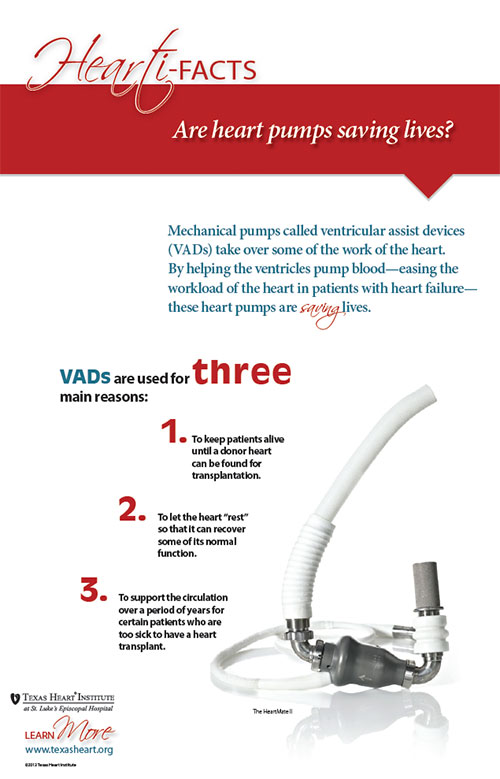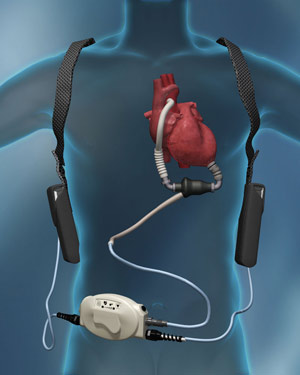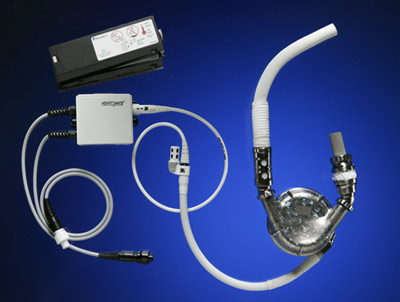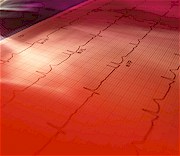
The lower chambers of the heart are called the ventricles. The lower-left chamber is called the left ventricle, and it is the heart's main pumping chamber. The lower-right chamber is called the right ventricle. When either of the ventricles is overworked, it can lead to heart failure.
Heart failure means the heart is weak, so blood cannot be efficiently pumped in or out of it. The slow onset and progression of heart failure is caused by the heart's own efforts to deal with its gradual weakening. The heart tries to make up for this weakening by getting larger, in an attempt to hold more blood inside it and maintain the same amount of blood pumped out of it.
In most patients, heart failure occurs because the left ventricle fails. As heart failure progresses, the stress on the left ventricle becomes so great that it cannot send enough blood to the body's other organs. When medicines and pacemakers no longer help the heart, patients need a heart transplant or a mechanical pump.
Sadly, though, there is a shortage of donor hearts for transplant. In the United States, as many as 50,000 people each year need a heart transplant, but only 2000 to 2500 people actually get one. That means many patients each year die while waiting for a heart transplant.
Because of this shortage of donor hearts, researchers have spent years developing mechanical pumps called ventricular assist devices (VADs). By taking over some of the work of the heart, VADs assist the heart by helping the ventricles pump blood, easing the workload of the heart in patients with heart failure. If the device is used to help (or "unload") the left ventricle, it is called a left ventricular assist device (LVAD). If it is used to "unload" the right ventricle, it is called a right ventricular assist device (RVAD).
What is a VAD?
Almost all VADs are made up of 3 parts:
- A pump that is implanted inside the body (an implantable VAD) or that is placed outside the body (an external or paracorporeal VAD)
- A system controller that stays outside the body and is used to program the settings of the VAD
- An outside energy source to power the pump—either a console or a battery pack.
How are implantable pumps placed inside the body?
For implantable VADs, the design and the size of the pump will determine where the pump is placed inside the body.
For VADs such as the HeartMate II® Left Ventricular Assist System and the DuraHeart™ Left Ventricular Assist System, the pump is implanted below the heart, in the upper abdomen. To implant these VADs, surgeons connect a tube (called an inflow graft) from the pump to the tip of the left ventricle. Another tube (called an outflow graft) is then connected from the pump to the aorta, which is the main artery that supplies blood to the body.
For another type of implantable VAD called the HeartWare® Ventricular Assist System, the pump is smaller, so the inflow graft is inserted into the tip of the heart and the pump sits in the fluid-filled space that surrounds the heart (called the pericardial space).
For RVAD implantation, the inflow graft is connected from the pump to the tip of the right ventricle, and the outflow graft is connected from the pump to the pulmonary artery, which is the main artery leading to the lungs.
Finally, for both LVADs and RVADs, another tube is attached to the pump and brought through the wall of the abdomen to the outside of the body, where it is attached to the pump's console or battery and control system.
How are paracorporeal pumps placed inside the body?
Paracorporeal VADs are inserted through a long thin tube (called a catheter) placed in the femoral vein or femoral artery.
One type of paracorporeal VAD, called the TandemHeart System, has an external pump that takes blood from a catheter placed in the patient's left atrium and sends it to the femoral artery.
Another type of paracorporeal VAD, called the Impella 2.5 Cardiac Assist Device, has a very small pump located on the tip of a catheter. The Impella catheter is inserted into the patient's femoral artery. A camera is then used to guide the Impella catheter into the left ventricle. The Impella works by sending blood from the left ventricle to the ascending aorta, which is the main blood vessel leaving the left ventricle.
How are paracorporeal VADs different?
Paracorporeal VADs are different from implantable VADs, because they are inserted with a catheter through a blood vessel and do not require open heart surgery. This type of VAD is usually for short-term support. Here are some reasons why patients may need a paracorporeal VAD:
- Their heart has been weakened after recent heart surgery (called cardiogenic shock)
- They cannot be weaned from the heart-lung machine after heart surgery
- They are waiting to get a long-term, implantable VAD
In some patients, paracorporeal VADS can be used for longer periods, such as while they are waiting for a heart transplant.
How does a VAD work?
With an LVAD, blood is drawn out of the left ventricle, into the pump, then into the aorta, and on to the body. With an RVAD, blood is drawn out of the right ventricle, into the pump, then into the pulmonary artery, and on to the lungs to pick up oxygen. A paracorporeal VAD works by moving oxygen-rich blood either from the left atrium or from the ascending aorta to the rest of the body. Depending on the type of VAD, it will be attached either to an external console that is plugged into an outlet in the wall or to a battery pack that can be worn over the shoulder.
Why do patients need a VAD?
The first decision a surgeon makes is whether a patient needs an RVAD and an LVAD (called biventricular support), or just an LVAD. For most patients, only the left ventricle needs support. If patients are very sick, in shock, or have liver or kidney failure, they may need biventricular support.
VADs are used for 3 main reasons:
- To keep patients alive until a donor heart can be found for transplantation. If this is the case, the VAD is used as a bridge to transplantation.
- To let the heart "rest" so that it can recover some of its normal function. In patients who have some heart recovery, also called heart failure remission, the device can be removed and a heart transplant may not be needed at all. If this is the case, the VAD is used as a bridge to recovery. These patients usually can go home and return to their normal activities after the VAD is implanted.
- To support the circulation over a period of years. This is usually the option for certain patients who are too sick to have a heart transplant. In this case, the VAD is used as destination therapy. Patients with this type of long-term support usually can go home and return to their normal activities after the VAD is implanted.
Transplant surgeons have also learned that long-term VAD support helps the function of the body's other organs, which makes patients stronger when the time comes for a heart transplant.
Are there different kinds of VADs?
Yes, a number of different VADs are available. Doctors choose the appropriate VAD based on the amount and type of heart assistance needed and on the size of the patient. Some VADs are too big to fit in small women or children.
VADs are also powered in different ways. Some VADs are powered by air, which comes from a large console. These air-powered pumps are used for short-term support or as a bridge to transplantation. One example of this type of LVAD is the HeartMate IP Left Ventricular Assist System.
|

HeartMate II Left Ventricular Assist System
with permission from Thoratec Corporation
|
Others are powered electrically, and they are for longer-term use. These pumps are much smaller in size than the air-powered types. And, because electrically powered VADs use a portable battery pack worn in a shoulder holster, these VADs make it easier for patients to move around. Some examples of electrically powered VADs are the HeartMate II Left Ventricular Assist System, the DuraHeart Left Ventricular Assist System, and the HeartWare Ventricular Assist System. All of these VADs have portable battery packs and a speed control that lets patients adjust the pump if they are increasing their activity level. Electrically powered LVADs let patients return to home and to work while they wait for a donor heart.
|

HeartMate XVE Left Ventricular Assist System
with permission from Thoratec Corporation
|
The Food and Drug Administration (FDA) has approved the HeartMate XVE® Left Ventricular Assist System for destination therapy. To date, this is the only type of VAD that is approved in the United States for this type of therapy.
See also on this site:
See on other sites:
National Heart Lung and Blood Institute
www.nhlbi.nih.gov/health/health-topics/topics/vad/
What is a Ventricular Assist Device?
American Heart Association
www.heart.org/HEARTORG/Conditions/HeartAttack/
PreventionTreatmentofHeartAttack/Implantable-Medical-Devices_UCM_303940_Article.jsp
Implantable Medical Devices
Updated August 2016



